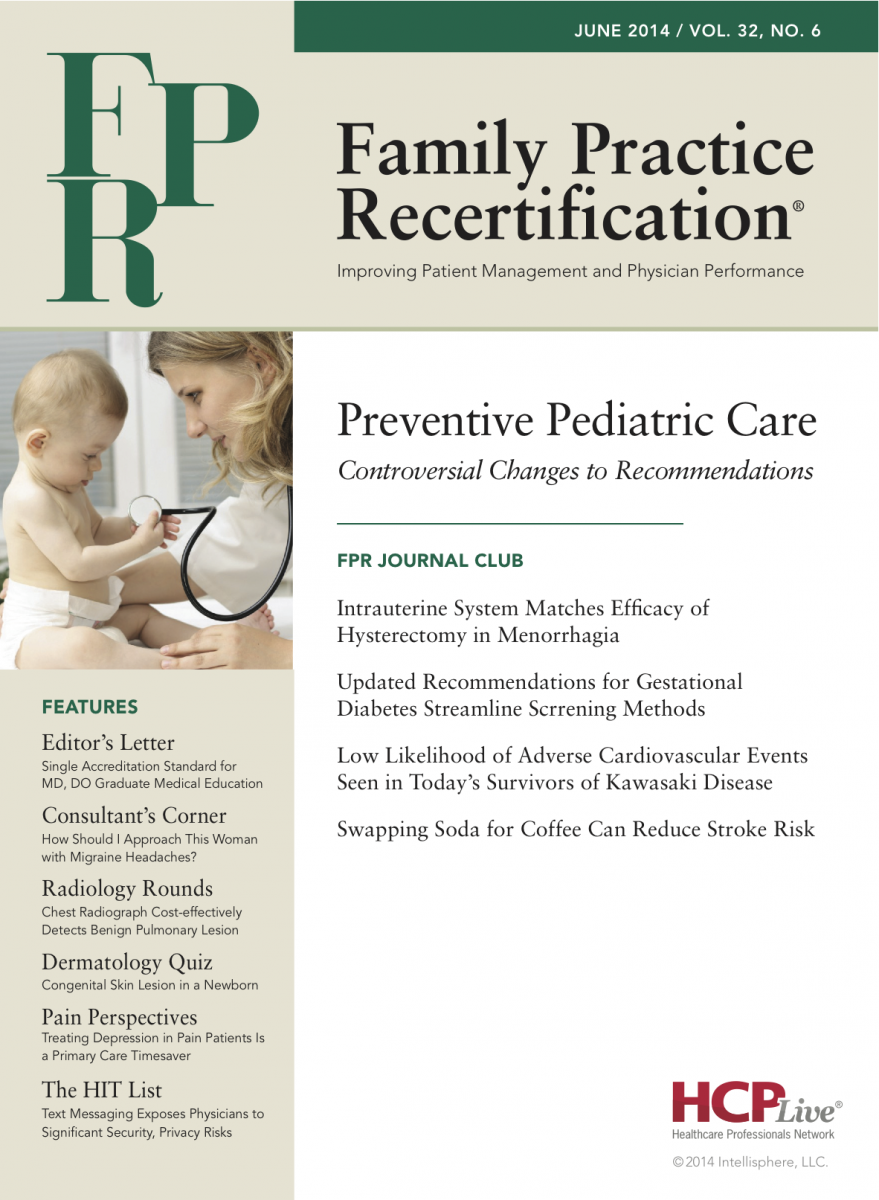Publication
Article
Family Practice Recertification
How Should I Approach This Woman with Migraine Headaches?
Author(s):
Although many migraine sufferers can abort their headaches with over-the-counter remedies, a significant percentage of patients require prescription medication for relief.

You see a 28-year-old African-American female who relates experiencing problems with headaches since her teenage years when they seemed to be associated with her menses. Over the past year, the patient has noted a monthly or bimonthly occurrence of severe headaches that have been consistently localized over the left periorbital area.
She describes the headaches as “throbbing” and ranks them as a "9" on a scale of 0-10. Her headaches are often preceded by a period of flickering lights in her field of vision and associated with nausea and occasional vomiting. She reports the episodes last up to a day, are made worse by loud sounds and bright lights, and are typically relieved by sleep. On a few occasions, she has experienced the onset of a headache after sexual intercourse.
What is the differential diagnosis?
The differential diagnosis is narrow in this case, considering the patient has suffered stereotyped headaches of one hour’s duration and associated symptoms of visual phenomena, nausea, and vomiting for over a year, which is consistent with migraine headache with aura.
Typically, there is concern for a space-occupying lesion or vascular lesion in those who present for the first time with migraine headache. However, there will usually be some atypical historical feature such as sudden onset or negative focal neurological symptoms to differentiate migraine from a vascular lesion, or focal findings on neurological examination to indicate the headache is secondary in origin.
Does this patient require a brain imaging study?
If she has a normal neurological screening examination, then she does not require brain imaging, as the US Headache Consortium suggests neuroimaging is not usually warranted for patients with migraine and normal neurological examination. Among patients who do not fulfill the strict definition of migraine or have atypical headache features or some additional risk factor like history of malignancy, a lower threshold for neuroimaging may be applied.
On the other hand, neuroimaging should be considered in patients with acute headache and unexplained abnormal findings on neurological examination. If brain hemorrhage is suspected, then computed tomography (CT) of the head is an appropriate first study; otherwise, magnetic resonance imaging (MRI) of the brain is the study of choice.
What type of migraine does this patient have?
The patient meets the clinical diagnostic criteria for both migraine with aura and without aura, as some headaches occur without her described visual symptoms.
What defines an “aura”?
Aura in migraine is defined as visual, sensory, and/or speech and language symptoms without signs of motor weakness. Aura gradually develops as a mix of positive features like seeing colored spots and negative features like loss of vision, though each symptom lasts no longer than 1 hour and reverses completely. Motor weakness as an aura symptom signals a diagnosis of hemiplegic migraine.
What are common precipitants of migraine?
Generally speaking, precipitants or “triggers” for migraine attacks are factors that throw a person out of physiological balance, including menses, dehydration, intense exercise, lack of or irregular sleep, and missed or delayed meals. A patient may find particular foods, alcohol, strong odors, or changes in atmospheric pressure trigger an attack, but instead of handing a patient one of several generic lists of identified triggers, I prefer to review a patient’s headache diary to recognize his or her specific precipitants.
What prescription agents can stop migraine headaches?
Although many migraine sufferers can abort their headaches with over-the-counter remedies, a significant percentage of patients require prescription medication for relief. Abortive medications from several classes may be used, including simple analgesics, non-steroidal anti-inflammatory drugs (NSAIDs), and serotonin receptor agonists like triptans and dihydroergotamine nasal spray.
What factors do you consider when recommending a specific triptan?
I typically consider contraindications to the class of medication, including uncontrolled hypertension, myocardial infarction (MI), transient ischemic attack (TIA), stroke, and claudication and angina, as well as procedures like coronary angioplasty, stenting or bypass surgery, carotid artery surgery or stenting, and peripheral artery bypass surgery. I also consider prior exposure to similar medications and headache characteristics that may necessitate one triptan over another.
For example, early emesis and/or nausea during a migraine attack would indicate the need for parenteral forms of triptan administration, while frequent headache recurrence would require an agent with a longer half-life, such as naratriptan or frovatriptan. Triptan-naïve patients may benefit from sumatriptan, rizatriptan, or eletriptan.
If one triptan fails, is it worthwhile to try a different one?
In the world of headache medicine, it is well-known that the efficacy failure of one triptan does not infer the ineffectiveness of all medications in the class. Therefore, it is worthwhile to consecutively try oral triptans and parenteral forms of the drugs.
How frequently can a patient safely use a triptan?
Each triptan medication has its own maximum daily dose as listed in the package insert. In general, once you take a second dose of an oral triptan after 2 hours, subsequent doses are not likely to be effective due to lack of efficient absorption. Additionally, if a triptan is used more than 10 days per month for more than 3 months, then there is significant risk for developing daily headaches from medication overuse.
When would you recommend preventive therapy?
The decision to recommend preventive therapy depends on the presence of functional disability; frequent headache, defined as >2 headaches per week; poor response to abortive medication; and/or the presence of rare forms of migraine, which warrant prevention even with infrequent attacks due to headache-related disability.
Which preventive agent do you favor as a first-line therapy?
The preventive medication I favor is the one that works. At this time, there is no tried-and-true method of determining which first-line medication will work in a given patient.
The most usual method of choosing a medication involves a combination of looking at comorbid conditions that may be addressed by a single medication, like a beta-blocker that treats both hypertension and migraine; recognizing useful side effects, since a migraine sufferer with insomnia may benefit from the sedative effect of a tricyclic antidepressant; and avoiding medications that may worsen comorbid conditions. In this patient, I would consider topiramate due to its tolerable side effect profile, weight-neutral effect, and good evidence for efficacy.
You decide to start the patient on topiramate. What dose would you start with and how would you titrate it?
In general, I always start at the lowest dose of a given medication to gauge the patient’s tolerance and adapt to its use. Then, I titrate the medication to an expected effective dose, usually changing it weekly until the desired dose is reached. The medication will begin to have an effect at about 3-4 weeks following initiation of therapy.
If the dose is well tolerated, then it may be increased until the desired therapeutic effect of reduced headache frequency and/or headache intensity is attained, or side effects are intolerable. Since frequent mistakes in preventive treatment include short medication trials and a lack of dose escalation, it is important to note therapeutic gain may be seen at upwards of 6 months after initiation of therapy for a given medication.
For topiramate, I start with 25 mg daily and increase the dose by 25 mg each week until the patient is receiving 75 mg daily, though that dose may be pushed to 125-150 mg daily if intolerable side effects are not incurred. In my experience, higher doses will likely bring out side effects that may be intolerable.
The most common side effect experienced by patients taking topiramate is paresthesias of the fingers and toes, which is usually well tolerated. About 11% of patients will experience weight loss, though it is rarely at a level that warrants discontinuing treatment. The most common concerning side effects are mood disturbance and/or cognitive slowing, which may necessitate treatment discontinuation. However, most patients are able to tolerate topiramate without difficulty.
If topiramate fails, what other options might you recommend?
If topiramate does not reduce headache frequency by 50%, lessen headache severity, improve response to abortive medication, and/or decrease headache-related disability, then I would consider another evidence-based preventive medication, such as propranolol, metoprolol, timolol, or valproic acid. Onabotulinum toxin A is only approved by the US Food and Drug Administration (FDA) for use in chronic migraine patients who experience more than 15 headache days per month.
Can a woman with migraine headaches safely use a combined oral contraceptive (OC)?
Most women with migraine headache without aura may use OCs if they are under 35 years of age and have no additional vascular disease risk factors. However, if a woman develops aura symptoms after starting an OC, then the birth control should be stopped because it will increase her risk of stroke and/or thromboembolism. In fact, female migraine sufferers with aura who use a low-dose OC have a 7 times greater risk for stroke than age-matched controls, while female smokers with migraine who take an OC pill have a 34 times greater stroke risk.
It is strongly suggested that women who experience migraine headache with aura use progestin-only formulations of OC pills.
About the Author

Charles Flippen II, MD, is Associate Professor of Neurology and Neurology Residency Program Director at the David Geffen School of Medicine at UCLA. All questions were posed by Family Practice Recertification Editor-in-Chief Martin Quan, MD.






